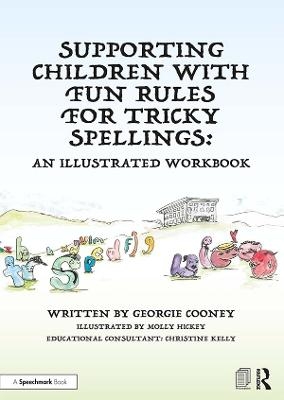
Supporting Children with Fun Rules for Tricky Spellings
Routledge (Verlag)
978-0-367-81962-0 (ISBN)
*This workbook should be used alongside the storybook, Who Put the Spell into Spelling?*
This illustrated workbook has been created to support learners who, after acquiring the basics of reading and writing, have struggled to organically grasp the rules that govern spelling in the English language. Each photocopiable worksheet is designed to support a key spelling rule, explored in the colourful storybook Who Put the Spell into Spelling? This activity workbook is designed to be used alongside the storybook.
Key features include:
Twenty-two activity worksheets designed to help learners understand and practise key spelling rules
Activities designed to support skills in reading, spelling and writing
Quirky illustrations designed to make the rules come to life
Developed with feedback from teachers and students, this is an invaluable resource for teachers and parents looking to support learners who find spelling a challenge, or who are learning English as an additional language.
Georgie Cooney currently lives and works in Ireland. She works for the Dyslexia Association of Ireland (DAI) and teaches students with Specific Learning Difficulties (SpLDs). Georgie has a website (Dyslexia Spell), which helps to give more information about her work and this can be found at: www.dyslexiaspell.com You can also find useful tips and advice on her youtube channel: dyslexiaspell and follow her on instagram or Facebook at dyslexiaspell.
Introduction
Worksheet 1
Worksheet 2 – Rule 1 – Magic E
Worksheet 3 – Rule 2 – V before E
Worksheet 4 – Rule 3 – Y takes the place of I and says its name
Worksheet 5 – Rule 4 – Y can sound like E’s name at the end of words
Worksheet 6 – Rule 5 – Doubling L, Z, F and S
Worksheet 7 – Rule 6 – C comes before K
Worksheet 8 – Rule 7 – T, C and H can go together after a single, short vowel sound at the end of a syllable
Worksheet 9 – Rule 8 – S comes before H, making one sound /sh/ after a short vowel sound at the end of a syllable
Worksheet 10 – Rule 9 – S is added to the end of most words to make plural nouns and to help verbs agree with subjects
Worksheet 11 – Rule 10 – E and S are added to the end of ‘hissing’ words to make plural nouns and to help verbs agree with subjects
Worksheet 12 – Rule 11 – V, E and S replace F when making plural nouns
Worksheet 13 – Rule 12 – I, E and S replace Y when making plural nouns and to help verbs agree with subjects
Worksheet 14 – Rule 13 – The letter name for O can end some words
Worksheet 15 – Rules 14 and 15 – the determiners: A comes before an consonant and ‘an’ comes before a vowel sound
Worksheet 16 – Rule 16 – I is a word on its own
Worksheet 17 – Rule 17 – I comes before E except after C and makes an /ee/ sound
Worksheet 18 – Rule 18 – Where there is a Q, it is always followed by U
Worksheet 19 – Rule 19 – W can change the vowel sounds that follow
Worksheet 20 – Rule 20 – T can change irregular verbs to put them in the past tense
Worksheet 21 – Rule 21 – Copycat C can be soft like S or hard like K
Worksheet 22 – Rule 22 – The sound for /y/ can only be heard at the beginning of words
Glossary
| Erscheinungsdatum | 01.04.2020 |
|---|---|
| Reihe/Serie | Who Put the Spell into Spelling |
| Illustrationen | Molly Hickey |
| Zusatzinfo | 15 Tables, black and white; 347 Line drawings, color; 347 Illustrations, color |
| Verlagsort | London |
| Sprache | englisch |
| Maße | 210 x 297 mm |
| Gewicht | 308 g |
| Themenwelt | Medizin / Pharmazie ► Gesundheitsfachberufe ► Logopädie |
| Sozialwissenschaften ► Pädagogik ► Schulpädagogik / Grundschule | |
| Sozialwissenschaften ► Pädagogik ► Sonder-, Heil- und Förderpädagogik | |
| ISBN-10 | 0-367-81962-7 / 0367819627 |
| ISBN-13 | 978-0-367-81962-0 / 9780367819620 |
| Zustand | Neuware |
| Informationen gemäß Produktsicherheitsverordnung (GPSR) | |
| Haben Sie eine Frage zum Produkt? |
aus dem Bereich


